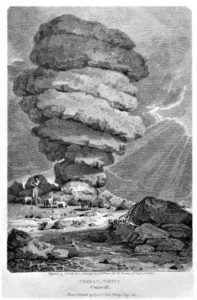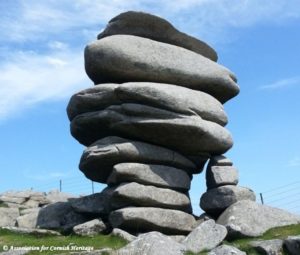Let's step into Cornish Heritage Trust history mysteries
After weeks cooped up it now looking like a free for all, within social distancing of course. Not all people are careful and with visitors heading for popular places perhaps it’s an opportunity to visit well-known, but perhaps not so busy Cornish places for a walk or picnic, being able to spread out and be safe whist seeing some of Cornwall’s many ancient heritage sites. Here are just three from my travels and are all managed by the Cornwall Heritage Trust [CHT] and free to visit. All these sites have parking available close by, but they so involve some walking.
At Carn Euny about 17 miles west of Penzance are the remains of a settlement dating from around the Iron Age 400 BCE to the Romano-British period about 400 AD. Discovered in the early 19th century with limited excavation on the fogou it wasn’t until 1920’s that some houses were examined. The area was cleared of gorse in 1953 and extensive excavations took place between 1964-1972. These settlements are known in Cornwall as courtyard house villages and this settlement also contains a fogou. This is an underground chamber what it was used for is undetermined, several theories have been suggested. Many pottery fragments were found and have helped date and provide information about this site. Carn Euny is great for children with lots of information boards and of course the fogou to discover. A smaller site than Chysauster it is free to enter. Membership of CHT allows free entry to Chysauster as well as other English Heritage sites in Cornwall.
Castle an Dinas close to St Columb Major and 7 miles from Newquay is an impressive hillfort, one of the largest and best preserved in Cornwall. Built around the 3rd century BC it has four concentric rings, one being very slight and possibly much older. Situated well above the surrounding countryside it must have been an imposing site to Iron Age people in its heyday. At the centre of the hillfort are the remains of 2 barrows and post hole excavations show that massive wooden gates would have guarded the entrance.
During the Civil War in 1645 a Royalist army camped here for a couple of nights prior to their surrender. For a period of 40 years 1916-1957 a tungsten mine operated just outside the hill fort. Excavations during the 1960’s discovered Iron Age pottery and sling stones. In 2009 substantial archaeological work was carried out including removal of a concrete structure and reconstruction of the damaged rampart plus provision of interpretation boards allowing visitors to learn more about this wonderful site. The stunning views from the top of Castle an Dinas are far reaching in all directions over the countryside.
A short video with accompanying music taken from the summit of Castle an Dinas showing a 360 degree view into the distance. Just a small taster for the real thing. Click on the above image and this will take you to the video on our YouTube Channel. [CLICK IMAGE LEFT]
Close to the village of Minions on Bodmin Moor there is a huge amount of ancient and industrial Cornish heritage along with stunning landscapes. A walk via the Hurlers stone circles to the Cheesewring and back includes views of Cornwall’s historic copper and lead mining within the landscape.
The Hurlers three stone circles although incomplete are part of a much larger Neolithic or early Bronze site, with other stones including The Pipers some 120 metres to the west. As with other stone circles there are many theories as to why these were built. However, Cornish folklore tells of men being turned into stone for hurling on a Sunday and this story was quoted by William Camden who wrote in 1587: "The neighbouring inhabitants terme them Hurlers, as being by devout and godly error perswaded that they had been men sometime transformed into stones, for profaning the Lord's Day with hurling the ball."
The Cheesewring on Stowes Hill is a wind sculpted rock formation approximately 32metres high and one of the most commented on places visited by early tourist to Cornwall. In 1842 Cyrus Redding wrote “These enormous rocks, thus resting upon each other cheese fashion, overhang their base so much that the wonder is how they sustain their position”. Naturally, there are Cornish folktales regarding them, one being they were formed by giants. The small pile of stones that appear to support this edifice do not actually do so. The other rock formations and views make this somewhere well worth visiting and a photo standing with this towering pile of stones to your back is definitely one for the family album.

![Carn Euny - Interpretation Board [1] Carn Euny - Interpretation Board [1]](https://www.cornwallheritage.com/wp-content/uploads/2020/09/Carn-Euny-Interpretation-Board-1-300x212.jpg)



![Castle-an-Dinas aerial view [CHT] Castle-an-Dinas aerial view [CHT]](https://www.cornwallheritage.com/wp-content/uploads/2020/07/Castle-an-Dinas-aerial-view-CHT-300x212.jpg)










